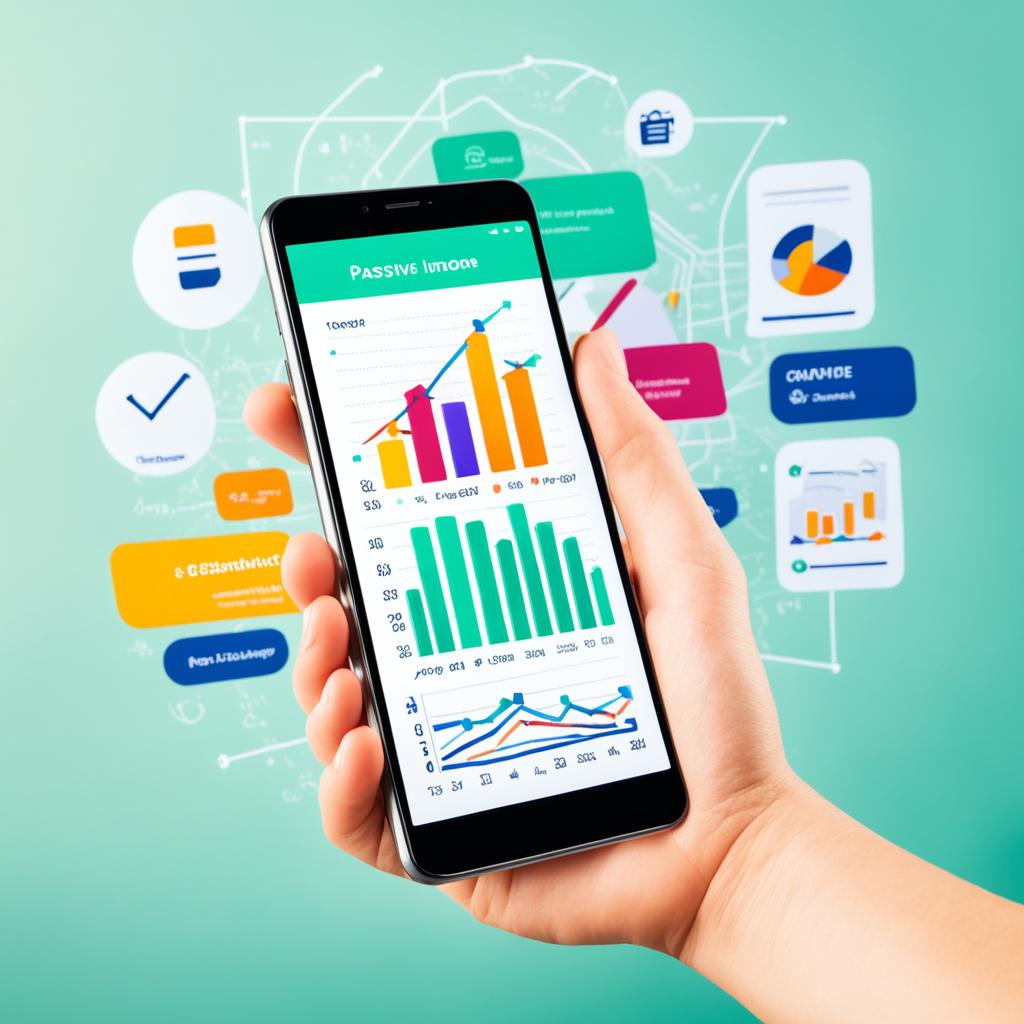Are you ready to turn your app idea into a lucrative income stream? With the booming mobile app market expected to hit $190 billion this year, now is the perfect time to develop a money-making app that generates passive income. The best part? You don’t need to be a coding expert to build a successful app; all you need is a great idea and the right guidance.
In this article, I will guide you through the process of creating a passive income app that can help you achieve financial freedom. From finding the perfect app idea to monetizing your app effectively, I’ll provide valuable insights and actionable tips along the way.
Key Takeaways:
- Developing a mobile app offers the opportunity to generate passive income and achieve financial freedom.
- Finding the right app idea is crucial for success; look for gaps in the market and identify potential niches.
- You don’t need coding skills to create an app; there are app development companies and no-code app builders available to bring your idea to life.
- Thorough market research helps you understand your target audience, identify profitable niches, and determine effective monetization strategies.
- Designing an engaging and user-friendly app is crucial for attracting and retaining users.
The Perks of Becoming an Appreneur
As someone who ventures into the app space, you have the opportunity to become an appreneur and enjoy the numerous advantages that come with it. Being an appreneur means entering a world of high demand, scalability, low maintenance, and the potential for financial freedom. Let me paint a picture of what this journey entails:
- High demand: The demand for mobile applications is constantly growing as more and more people rely on smartphones in their daily lives. Whether it’s for productivity, entertainment, communication, or any other need, there is a vast audience waiting to discover the next innovative app.
- Scalability: One of the greatest advantages of app development is the ability to scale your business rapidly. With the right idea and execution, your app has the potential to reach millions of users worldwide, offering unlimited growth opportunities.
- Low maintenance: Unlike traditional brick-and-mortar businesses, app development requires minimal ongoing maintenance. Once your app is live, updates and bug fixes can be easily implemented, allowing you to focus on scaling your user base and optimizing your revenue streams.
- Barrier to entry: In the app space, barriers to entry are relatively low compared to other industries. You don’t need a large capital investment or extensive resources to get started. With a great idea, determination, and the right tools, you can turn your app dreams into reality.
But perhaps the most intriguing perk of becoming an appreneur is the ability to break free from the traditional 9 to 5 routine. As an appreneur, you have the flexibility to work from anywhere, embrace the digital nomad lifestyle, and shape your own schedule. No more commuting or punching the clock. Instead, you have the freedom to create your own path to financial freedom.
“Becoming an appreneur offers the chance to break free from the constraints of a 9 to 5 routine and achieve financial freedom through the limitless opportunities of the app space.”
Image:
Finding the Right Idea
Finding the right app idea is crucial when embarking on the journey of app development. To create a successful app, it’s important to look for gaps in the market and identify potential niches that have significant market demand. By doing so, you can tap into a target audience’s needs and preferences, increasing the chances of your app’s success.
Let’s take a look at an example to understand this better. The My Typewriter app is a perfect illustration of how identifying market demand can lead to a successful app idea. With the rise of social media platforms like Facebook, Instagram, and Snapchat, people started expressing their creativity through unique and vintage typography. There was a clear demand for typewriter fonts to add nostalgia and personality to their posts.
To cater to this market demand, the creators of the My Typewriter app developed a simple and intuitive app that allows users to access a wide range of vintage typewriter fonts. With the app’s seamless integration with popular social media platforms, users can effortlessly enhance their posts with a touch of nostalgia and creativity.
“My Typewriter app revolutionized the way people express their creativity on social media platforms. It tapped into a market demand for vintage typewriter fonts, bringing a unique and personalized touch to users’ posts.” – AppReview
By identifying this untapped niche in the market and developing an app that catered to the specific needs of users, the creators of the My Typewriter app not only fulfilled a demand but also carved out a profitable space for themselves in the app market.
When brainstorming app ideas, consider the market demand for certain features, functionalities, or themes. Think about the problems users face and how your app can offer a solution or add value to their lives. Conduct thorough research, analyze trends, and pay attention to user feedback on existing apps in your target niche to identify gaps that you can fill with your app idea.
Remember, finding the right app idea is the foundation of a successful app. It sets the stage for further development, user engagement, and ultimately, the opportunity to generate passive income. So put your thinking cap on, explore various markets, and discover the app idea that has the potential to make a significant impact.
The Role of Coding in App Development
When it comes to developing an app, coding is often seen as a barrier for non-coders. However, the good news is that you don’t need to be able to code to bring your app idea to life. There are app development companies that specialize in turning your concept into a fully functioning app.
By partnering with a local development firm, you can benefit from face-to-face meetings and build rapport with the team working on your app. This collaboration allows you to communicate your ideas effectively and ensure that the final product meets your expectations.
Whether you lack coding skills or simply prefer to focus on the creative and strategic aspects of app development, outsourcing the technical side to experts can save you time and effort. It also allows you to tap into their knowledge and experience, ensuring that your app is developed to the highest standard.
Benefits of Hiring a Development Firm
- Access to coding expertise: While you may not be familiar with coding, a development firm has a team of skilled professionals who specialize in different programming languages and frameworks. They will handle the coding aspect so that you can focus on the overall vision and functionality of your app.
- Efficient development process: Hiring a development firm ensures that your app is built efficiently and in a timely manner. Their experience in the field allows them to follow best practices and streamline the development process, saving you time and avoiding potential pitfalls along the way.
- Quality assurance and testing: A reputable development firm will have a rigorous quality assurance process in place, which includes extensive app testing. This ensures that your app functions smoothly, and any bugs or issues are identified and fixed before launching.
- Ongoing support and maintenance: After your app is launched, a development firm can provide ongoing support and maintenance. They can help with updates, bug fixes, and enhancements, ensuring that your app stays up-to-date and continues to meet the needs of your users.
Don’t let the coding aspect hold you back from creating your dream app. With the help of a development firm, you can turn your ideas into reality and join the ranks of successful app developers, even as a non-coder.
Image of non-coder developing an app
The Importance of Market Research
When it comes to creating a successful passive income app, conducting thorough market research is absolutely crucial. Market research allows you to gather valuable insights and make informed decisions about your app’s niche, target audience, pricing strategy, and monetization model.
One of the first steps in market research is identifying a profitable niche for your app. By exploring different app categories and analyzing market gaps, you can uncover opportunities to cater to specific user needs and stand out from competitors.
Understanding user demographics is another vital aspect of market research. By gaining insights into your target audience’s preferences, behaviors, and pain points, you can tailor your app’s features, design, and marketing strategies to resonate with your users on a deeper level.
“Market research allows you to gather valuable insights and make informed decisions about your app’s niche, target audience, pricing strategy, and monetization model.”
Pricing strategy is a critical consideration for app success. Through market research, you can determine the optimal price point for your app, taking into account factors such as user willingness to pay, perceived value, and competition within the app market.
Monetization model is another vital aspect that market research can help you with. By understanding the various monetization options available, such as in-app advertising, in-app purchases, or subscription models, you can choose the most suitable strategy for maximizing your app’s revenue potential.
Let’s take a closer look at the importance of market research in the form of a table:
| Benefits of Market Research for Passive Income App Development | Description |
|---|---|
| Identifying a Profitable Niche | Market research helps you find gaps in the market and determine the most lucrative niche for your app. |
| Understanding User Demographics | By analyzing user demographics, you can tailor your app to meet the specific needs and preferences of your target audience. |
| Determining Pricing Strategy | Through market research, you can identify the optimal price point for your app based on user willingness to pay and market competition. |
| Selecting the Right Monetization Model | Market research helps you choose the most effective monetization strategy, such as in-app ads, in-app purchases, or subscriptions, to maximize revenue. |
By conducting comprehensive market research, you can set a solid foundation for the development and success of your passive income app. It empowers you to make data-driven decisions and ensure that your app meets the needs and desires of your target audience.
Choosing the Right Platform and Tools
When developing a mobile app, choosing the right platform and development tools is crucial for ensuring its success. Factors such as target audience, budget, and development timeline should be carefully considered in order to make an informed decision. Let’s explore the different options available:
iOS
If your target audience primarily consists of Apple users, developing your app for iOS may be the best choice. The iOS platform provides a seamless user experience and offers a range of development tools and resources to help you create a high-quality app.
Android
On the other hand, if you want to reach a wider audience and have more flexibility with your app, developing for Android is a great option. The Android platform offers a larger user base and a variety of development tools to suit your needs.
Cross-Platform Development
If you want to save time and resources by developing your app for multiple platforms simultaneously, cross-platform development is the way to go. Cross-platform frameworks like React Native and Xamarin allow you to write code once and deploy it on both iOS and Android platforms. This streamlines the development process and ensures consistency across different platforms.
Here’s a comparison table to help you make an informed decision:
| Platform | Advantages |
|---|---|
| iOS | Seamless user experience Strong developer tools Targeted Apple user base |
| Android | Wide user base Flexible development options Greater customization |
| Cross-Platform | Development efficiency Consistency across platforms Time and cost savings |
Consider which platform aligns best with your target audience and business objectives. You can also consult with app development experts to guide you in making the right choice.
Next, let’s explore the development tools available:
React Native
React Native is a powerful cross-platform framework that allows you to build mobile apps using JavaScript. It leverages the power of React, a popular JavaScript library, to create native-like user interfaces across multiple platforms.
Xamarin
Xamarin is another cross-platform framework that uses C# to build native apps for iOS and Android. It provides a rich set of development tools and allows for code sharing, resulting in efficient development and maintenance.
By selecting the right platform and development tools, you set the foundation for a successful app. Remember to consider your target audience, budget, and development timeline when making these important decisions.
No-Code App Builders
If you don’t want to code or hire a developer, you can use no-code app builders to create an app. These builders provide a simple drag-and-drop interface for app development. One popular option in the market is nandbox, a native app builder that allows you to create robust applications without any coding knowledge.
Nandbox offers a user-friendly platform that empowers individuals to design and build their own apps. With its intuitive interface, you can easily drag and drop elements to customize your app’s layout, features, and functionalities. Whether you want to create a business app, social networking platform, or e-commerce store, nandbox provides the tools and resources you need for app development without coding.
Using a no-code app builder like nandbox saves you time and money, eliminating the need to learn complex programming languages or hire a dedicated developer. It puts the power in your hands, allowing you to transform your unique app idea into a functional and visually appealing application.
With nandbox’s native app builder, you can:
- Create custom user interfaces and layouts
- Add interactive features like buttons, forms, and menus
- Integrate social media platforms for seamless user engagement
- Implement in-app purchases and monetization strategies
- Test and preview your app before launching it to the app stores
No-code app builders have revolutionized the app development industry, empowering individuals with innovative ideas to bring their visions to life. Whether you’re a small business owner, entrepreneur, or simply someone with a unique app concept, nandbox and other similar platforms provide a seamless solution for creating stunning mobile applications without coding.
| Benefits of No-Code App Builders | Challenges of No-Code App Builders |
|---|---|
| – User-friendly interface and intuitive tools | – Limitations in customization compared to custom coding |
| – Cost-effective alternative to hiring a developer | – Limited access to advanced functionalities |
| – Quick turnaround time for app development | – Potential reliance on the builder’s infrastructure and updates |
| – No coding knowledge or experience required | – Difficulty in troubleshooting complex issues |
Remember, while no-code app builders provide a convenient way to develop apps without coding, they may not be suitable for every project. Complex applications with unique functionalities may still require custom coding and the expertise of experienced developers. Consider your app’s requirements and goals when deciding whether a no-code app builder like nandbox is the right choice for you.
Designing an Engaging App
When it comes to creating a successful app that generates passive income, design plays a crucial role. Designing an engaging app that captivates users and keeps them coming back for more is key to its success. By focusing on creating a user-friendly interface, incorporating intuitive user interface elements, providing clear instructions, and utilizing features that enhance user engagement, you can create an app that stands out in the competitive digital market.
Creating a User-Friendly Experience
A user-friendly app is essential for attracting and retaining users. When designing your app, consider the following:
- Implement an intuitive user interface that allows users to navigate through the app effortlessly.
- Use clear instructions and user-friendly prompts to guide users through the app’s features and functionalities.
- Ensure that the app’s layout and design are visually pleasing and easy to understand.
- Optimize the app’s performance to ensure swift loading times and smooth transitions.
Enhancing User Engagement
User engagement is key to the success of any app. To enhance user engagement, consider the following:
- Implement features that encourage users to interact with the app, such as in-app purchases, rewards, and gamification elements.
- Utilize push notifications to keep users informed about app updates, new features, and relevant news.
- Integrate social media functionality to allow users to share their app experience and engage with others.
By continuously updating and improving your app based on user feedback, you can ensure that your app remains engaging and relevant over time. Regularly analyze user behavior and preferences to make data-driven decisions and optimize the user experience.
“Design is not just what it looks like and feels like. Design is how it works.” – Steve Jobs
By following these design principles and incorporating user-friendly elements into your app, you can create an engaging and successful mobile application that generates passive income. Remember, designing an app that users love will not only increase user retention but also drive organic growth through positive user reviews and word-of-mouth recommendations.
| Key Design Elements | Benefits |
|---|---|
| User-Friendly Interface | Enhanced user experience and increased customer satisfaction. |
| Intuitive User Interface | Easier navigation and reduced learning curve for users. |
| Clear Instructions | Improved app usability and reduced user frustration. |
| User Engagement Features | Increased user retention and enhanced app monetization opportunities. |
| In-App Purchases | Potential revenue generation through virtual goods or premium features. |
| Push Notifications | Ability to keep users informed and engaged with app updates. |
| Social Media Integration | Opportunity for users to share their experience and increase app visibility through social platforms. |
Testing and Quality Assurance
Once you’ve developed your app, it’s crucial to thoroughly test its functionality and ensure a seamless user experience before publishing it. Testing helps identify and fix any bugs or issues that could impact the app’s performance. Additionally, collecting user feedback and making necessary adjustments based on their input can further enhance the app’s usability.
Testing involves systematically examining different aspects of the app, such as its features, user interface, and performance, to ensure everything works as intended. By conducting comprehensive app testing, you can identify and correct any potential issues before they impact the user experience.
Fixing bugs and addressing user feedback are integral parts of the testing and quality assurance process. It’s important to address any reported issues promptly and ensure that the necessary improvements are made to deliver a seamless user experience.
Regularly reviewing and refining your app based on user feedback contributes to its overall success and helps create a loyal user base. By providing a reliable and enjoyable app experience, you increase the chances of users recommending your app to others and generating positive reviews.
Remember, a seamless user experience is key to retaining and attracting users. By prioritizing app testing, bug fixing, and user feedback, you can ensure that your app provides the best possible experience for its users.
Monetizing Your App
Once you have developed your mobile app and gained a user base, it’s time to start monetizing it. There are various strategies you can implement to generate revenue from your app. Here are some effective ways to monetize your app:
- In-App Advertising: Utilize in-app advertising to display relevant ads to your users. This can be done through third-party ad networks such as Google AdMob or Facebook Audience Network. By displaying ads within your app, you can earn revenue based on clicks, impressions, or conversions.
- In-App Purchases: Offer additional features, content, or virtual goods within your app for users to purchase. In-app purchases can range from unlocking premium content to buying virtual currency or items. This strategy allows users to enhance their app experience while providing you with a steady revenue stream.
- Subscription Models: Implement subscription-based pricing for access to exclusive content, premium features, or enhanced functionality. Subscriptions can be offered on a monthly, quarterly, or annual basis, providing a recurring revenue stream for your app.
- Analyzing User Data: Regularly analyze user data to gain insights into user behavior, preferences, and engagement with your app. This information can help you optimize your app’s monetization strategy and make data-driven decisions to improve revenue generation.
- Exploring Multiple Revenue Streams: Don’t limit yourself to a single monetization method. Consider combining multiple strategies to diversify your revenue streams and maximize your earnings. For example, you can combine in-app advertising with in-app purchases or subscriptions.
Remember, the key to successful app monetization is finding the right balance between generating revenue and providing value to your users. It’s essential to prioritize user experience and deliver valuable content or features to encourage user engagement and retention.
Case Study: App Monetization Strategies
Let’s take a look at the app “Foodie Delight,” a popular recipe app that offers users access to a vast collection of delicious recipes. The app incorporates multiple monetization strategies to generate revenue:
| Monetization Strategy | Explanation |
|---|---|
| In-App Advertising | Foodie Delight displays targeted ads from food-related brands and sponsors, generating revenue based on ad impressions and clicks. This allows the app to remain free for users while generating income. |
| In-App Purchases | The app offers users the option to purchase an ad-free version of the app for a one-time fee. This provides an additional revenue stream for Foodie Delight and improves the user experience for users who prefer an uninterrupted recipe browsing experience. |
| Subscription Models | Foodie Delight also offers a premium subscription plan that gives users access to exclusive recipes, personalized meal plans, and cooking tutorials. Users can choose a monthly or annual subscription, providing recurring revenue for the app. |
By implementing a combination of in-app advertising, in-app purchases, and subscription models, Foodie Delight has successfully monetized its app while delivering value to its users.

Analyzing user data is crucial for optimizing revenue streams and improving app monetization. By regularly tracking user engagement, preferences, and behavior, you can make data-driven decisions to enhance user experience and maximize monetization opportunities.
“Diversifying your app’s revenue streams is key to long-term success. By combining various monetization strategies and consistently analyzing user data, you can optimize your app’s earning potential.”
– Appreneur Magazine
Google Play vs. Apple App Store
When it comes to distributing your app, you have two major platforms to choose from: Google Play and the Apple App Store. Each platform has its own unique characteristics and user base, which can significantly impact the success of your app. It’s important to be aware of the platform differences, user base, app performance, and market reception when making your decision.
Platform Differences
Google Play and the Apple App Store differ in terms of their operating systems, app approval process, and revenue models.
“The Google Play Store primarily caters to devices running on the Android operating system, while the Apple App Store is exclusive to iOS devices. This means that if you want to target Android users, Google Play is the way to go. On the other hand, if you want to reach iPhone and iPad users, the Apple App Store is your platform of choice.”
User Base
The user base of Google Play and the Apple App Store varies in terms of demographics and preferences.
“Google Play has a larger number of app downloads globally, making it a potential gateway to a wider audience. Additionally, Android users tend to be more diverse and spread across different income brackets. On the other hand, the Apple App Store has a more affluent user base, which can be advantageous for apps targeting specific niches or premium app offerings.”
App Performance
The performance of your app on Google Play and the Apple App Store can also differ based on factors such as user engagement, app discoverability, and revenue potential.
“Google Play offers more flexibility in terms of app discoverability and updates, allowing developers to experiment and optimize their app performance. On the other hand, the Apple App Store has a reputation for higher app quality standards and stronger monetization potential, with iOS users generally spending more on in-app purchases.”
Market Reception
The market reception for apps on Google Play and the Apple App Store can vary based on regional preferences and market trends.
“The market reception for apps can differ between Google Play and the Apple App Store based on various factors such as user behaviors, competition, and localization. It’s important to consider the target markets and cultural preferences when evaluating the potential success of your app on each platform.”
Ultimately, the platforms you choose to distribute your app will depend on various factors such as your target audience, app requirements, and monetization strategy. It may be beneficial to prioritize one platform over the other based on your specific goals and resources.
| Criteria | Google Play | Apple App Store |
|---|---|---|
| User Base | Diverse and spread across income brackets | Affluent and premium app-oriented |
| Operating System | Android | iOS |
| App Approval Process | Relatively lenient | Strict quality standards |
| App Discoverability | More flexible | Stronger curation |
| Revenue Potential | Opportunity for wider audience, in-app ads | Higher spending on in-app purchases |
Repeat and Scale
Once you’ve created a successful app, it’s time to think big and explore new opportunities. By building a portfolio of apps, you can maximize your passive income and potentially become a smartphone app mogul. Scaling your efforts is the key to unlocking significant earnings and long-term financial success.
Why Build an App Portfolio?
Building an app portfolio allows you to diversify your income streams and mitigate risks. By having multiple apps in your portfolio, you can generate revenue from different sources and reduce reliance on a single app for your passive income. It also opens up chances to explore various niches and cater to different user demographics.
Expanding Your Passive Income
Expanding your app portfolio provides the opportunity to multiply your passive income streams. Each successful app adds to your revenue and increases the potential for ongoing profits. The more apps you have, the more users you can reach and monetize. This strengthens your position as an app entrepreneur and enhances your financial independence.
Creating a Strategic Plan
To effectively repeat and scale your app endeavors, it’s essential to create a strategic plan. Start by analyzing your target audience and identifying their needs and preferences. This will help you develop new app ideas that align with market demands and trends. Consider factors such as user engagement, monetization strategies, and potential synergy between your apps.
Managing Your App Portfolio
Managing your app portfolio requires careful monitoring and optimization. Regularly track app performance metrics, user feedback, and market trends to identify areas for improvement. Continuously update and enhance your apps to keep them relevant and engaging. This proactive approach ensures that your app portfolio stays profitable and adaptable to changing user expectations.
Maximizing Revenue Opportunities
As an app mogul, you have the advantage of exploring various revenue models and strategies. Leverage in-app advertising, in-app purchases, and subscription services to maximize your earnings. Conduct thorough market research and analyze user data to identify the most effective revenue streams for each of your apps. By optimizing monetization, you can unlock the full income potential of your app portfolio.
By expanding your app portfolio, you can create a sustainable and lucrative source of passive income. Scale your efforts strategically and manage your apps effectively to become a successful app mogul. With dedication, creativity, and a smart business mindset, you can achieve financial freedom and build a lasting legacy in the mobile app space.
| Advantages of Building an App Portfolio |
|---|
| Diversifies income streams |
| Reduces reliance on a single app |
| Expands reach and user base |
| Increases potential for ongoing profits |
| Allows exploration of different niches |
| Maximizes revenue opportunities |
Building a Passive Income App with No Programming Background
Creating a passive income app might seem daunting, especially if you have no programming background. However, with the right tools and guidance, it’s entirely possible to develop a successful app and start generating passive income. Here’s a step-by-step guide to help you get started.
Step 1: Get a Google Developer Account
The first step in building your passive income app is to create a Google Developer Account. This account will give you access to the Google Play Store, where you can publish and distribute your app to millions of Android users. Simply visit the Google Play Developer Console website and follow the instructions to set up your account.
Step 2: Download Android Studio
While you may not need to code your app from scratch, having a basic understanding of the development process can be beneficial. Android Studio is a powerful development environment that provides the necessary tools and resources for app creation. Download and install Android Studio to familiarize yourself with the app development workflow.
Step 3: Incorporate In-App Advertisements with AdMob
Monetizing your app through in-app advertisements can be an effective way to generate passive income. AdMob is a popular advertising platform owned by Google that allows you to display targeted ads within your app. Integrate AdMob into your app by following its documentation and guidelines. This will enable you to earn revenue whenever users interact with the ads.
Step 4: Set up AdSense for Payment Transfer
Once you start earning revenue from your app, you’ll need a way to receive payments. AdSense, also owned by Google, is a program that enables you to monetize your app by displaying ads. It provides various payment options, including wire transfer and checks. Sign up for an AdSense account and link it to your Google Developer Account to receive payments from your app’s ad revenue.
By following these steps, you can create a passive income app without any programming background. Remember to develop a unique app idea, conduct market research, and design an engaging user interface to attract users and maximize your app’s potential.
Conclusion
Creating a mobile app that generates passive income is the key to achieving financial freedom. By following the right strategies in app development, market research, and monetization, you can create a successful app and reach your income goals. The best part is that you don’t need to have coding knowledge to get started. There are plenty of resources and tools available to help you bring your app idea to life.
Mobile app revenue is expected to reach new heights, providing a lucrative opportunity for entrepreneurs. Developing a passive income app allows you to tap into this growing market and build a sustainable income stream. Whether you choose in-app advertising, in-app purchases, or subscription models, analyzing user data and optimizing your revenue streams will be crucial.
Don’t let the lack of coding skills hold you back. Find the right app idea, conduct thorough market research, and choose the right platform and tools that suit your target audience. With dedication and persistence, you can create a portfolio of successful apps that generate a steady passive income. Start your journey towards financial freedom and become an app mogul!
FAQ
How can I create a mobile app that generates passive income?
What are the advantages of becoming an appreneur?
How do I find the right app idea?
Do I need coding skills to develop an app?
How important is market research in app development?
What factors should I consider when choosing a platform and development tools?
Can I create an app without coding?
How important is app design for its success?
How important is testing for my app?
What are the different ways to monetize my app?
What are the differences between Google Play and the Apple App Store?
Is it possible to generate additional passive income by building multiple apps?
Can I build a passive income app without a programming background?
Source Links
- https://www.linkedin.com/pulse/how-build-app-generates-passive-income-connor-garrett
- https://nandbox.com/passive-income-app-development-the-comprehensive-guide/
- https://medium.com/illumination/generating-passive-income-of-1500-a-month-by-launching-own-app-6-easy-steps-8ae0640d73f
Money posts:
 Top 5 Ways to Get Paid to Code in 2024
Top 5 Ways to Get Paid to Code in 2024
 Top 6 Programming Languages (& Learn Free) (2024)
Top 6 Programming Languages (& Learn Free) (2024)
 What is Passive Income & Why It’s So Important in 2024
What is Passive Income & Why It’s So Important in 2024
 How to Make Money Blogging | Average Blogger Salary in 2024
How to Make Money Blogging | Average Blogger Salary in 2024
 How Much Do Twitch Streamers Make in [Year]
How Much Do Twitch Streamers Make in [Year]
 How Much Do Bloggers Make? How They Make Money & (2024)
How Much Do Bloggers Make? How They Make Money & (2024)
 How to Create a YouTube Channel and Make Money
How to Create a YouTube Channel and Make Money
 Earning Through Podcasting For Beginners Step By Step (2024)
Earning Through Podcasting For Beginners Step By Step (2024)

